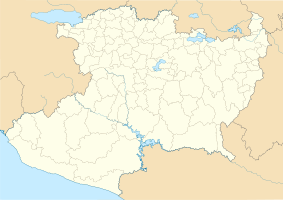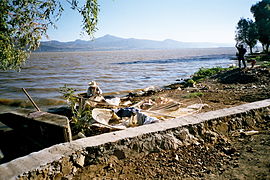Pátzcuaro
| Pátzcuaro | ||
|---|---|---|
|
Coordinates: 19 ° 31 ′ N , 101 ° 37 ′ W Pátzcuaro on the map of Michoacán
|
||
| Basic data | ||
| Country | Mexico | |
| State | Michoacan | |
| Municipio | Pátzcuaro | |
| City foundation | 1540 | |
| Residents | 55,298 (2010) | |
| Detailed data | ||
| height | 2140 m | |
| Post Code | 61600 | |
| prefix | 434 | |
| City Presidency | Salma Karrum Cervantes | |
| Website | ||
| Evening mood in Pátzcuaro | ||
| Butterfly fishermen in Pátzcuaro | ||
| The church in the Plaza de San Agustín | ||
Pátzcuaro is a small town on Lake Pátzcuaro in the Mexican state of Michoacán and the seat of the municipality of the same name Pátzcuaro . In the Purépecha language , the name means "place of stones". The place is a Pueblo Mágico .
geography
location
Pátzcuaro is located in the mountains, the Purépecha plateau , in the Mexican state of Michoacán, and now has several pine forests. To the north is Lake Pátzcuaro , one of the highest lakes in Mexico. The butterfly fishermen there have become a symbol of Mexico and are also depicted on the 50 peso banknotes. Pátzcuaro is located between the cities of Morelia and Uruapan and is about an hour's drive from both cities.
climate
Due to the altitude, the climate in Pátzcuaro is relatively mild for Mexico.
history
Pátzcuaro was officially founded in 1540. The city quickly developed into a religious center and the early residents of Pátzcuaro believed that the city was the gateway to heaven, where the gods came and went. The real reason for the religious development of the place lies in its pre-colonial history: The Purépecha people already settled here under their King Curateme in 1324. In 1362 it was completely renovated by Fanacun. The original name was Tzacapu-ansucutin-patzcuaro : gateway to heaven or place where one makes the blackness. Today's shortened name Pátzcuaro means place of stones or place of joy. When the Spanish conquerors under Nuño Beltrán de Guzmán plundered this area in search of gold and the Purépecha king at that time did not want to or could not reveal the gold hiding places, he was burned alive. These acts of violence against the indigenous people resulted in his being replaced by the priest and legal scholar Don Vasco de Quiroga . Don Vasco de Quiroga helped the Purépechas with the establishment of schools and hospitals. To this day he is revered by the locals in Pátzcuaro and affectionately called Tata Vasco .
Pátzcuaro stood during the Reform War (1858–1861) on the side of the conservatives and the empire . In 1886 the railway to Morelia was opened. The Mexican Revolution reached Pátzcuaro on April 21, 1913. In 1940, the First Inter-American Conference on Indian Life was held in Pátzcuaro from April 14 to 24, 1940 (German roughly: "First All -American Conference on Indian Life ").
Economy and Infrastructure
Pátzcuaro 's main sources of income are tourism and fishing in the lake of Pátzcuaro. A special feature are the fishing boats, which have nets like butterfly wings, but are now only admired by tourists.
Markets and shopping
Pátzcuaro has a lot of markets. On Friday the big market takes place in the city, where the indigenous people from the surrounding villages come to sell their goods. In Pátzcuaro there is also one of the few markets in Mexico where barter is accepted as originally.
tourism
Pátzcuaro has been declared a Pueblo Mágico , i.e. a magical place - not least because of this, Pátzcuaro is one of the major tourist destinations in the Mexican interior. The cityscape in the center has been standardized: white facades, red tile roofs and the same fonts and colors for signs.
Attractions
The Plaza Vasco de Quiroga , along with the Plaza de Armas in Nazca (Peru), is the only main square in Latin America that is not connected to a religious building. Here you will find a house with a walled-up window that goes back to the tragic story between an improper couple in love.
In the east of the city you can find the Basílica de Nuestra Señora de la Salud , which was built between 1546 and 1554. This church is still very venerated by the indigenous peoples, because this is where Vasco de Quiroga is buried.
Another important sight is the Callejuela de los Once Patios , an old monastery with winding streets and eleven courtyards. Today you can marvel at and purchase Pátzcuaros handicrafts.
gastronomy
In Pátzcuaro you eat a lot of fish from the nearby lake. The blanco de Pátzcuaro , for which the lake is known, is threatened with extinction. The ice cream, which is sold in all flavors in the Plaza Vasco de Quiroga, has also achieved national fame.
Culture
The Baile de los viejitos (Dance of the Old People), one of the most famous indigenous dances in Mexico, is performed on Wednesdays and Saturdays at 9 p.m. in Don Vasco's Best Western Posada. The dancers wear wooden masks depicting smiling elderly people to show that, at least in Mexico, old age is not a cause for despair, but an occasion for exuberance.
sons and daughters of the town
- Estanislao Alcaraz y Figueroa (1918-2006), Archbishop of Morelia
- Silviano Carrillo y Cárdenas (1861–1921), Bishop of Sinaloa
- Carlos Amado Molina (* 1983), professional boxer
- Alfredo Zalce (1908–2003), artist
Web links
Individual evidence
- ↑ Oscar L. Chapman (Ed.): Final Act of the First Inter-American Conferenc on Idian Life . Conference report of the US delegation, online at www.hathitrust.org (English)



